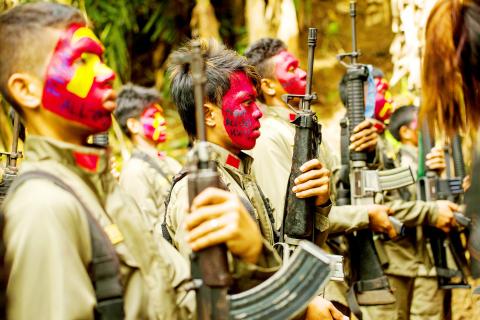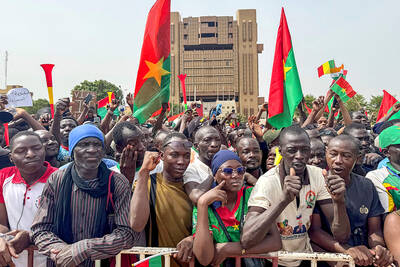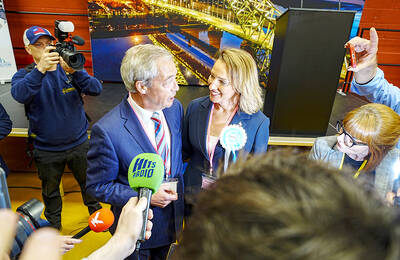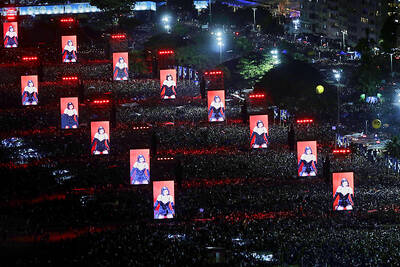Philippine police officer Ruby Buena’s introduction to one of the oldest communist insurgencies in the world was a roadside bomb blast followed seconds later by an eruption of gunfire.
“I thought it was my time to die,” said 25-year-old Buena, who instead woke up in a hospital with a cracked pelvis to learn three of her colleagues were dead in last year’s attack in the central Philippines.
In a nation plagued by armed groups ranging from kidnap-for-ransom outfits to Muslim secessionist movements, the communist New People’s Army (NPA) is among the deadliest.

Photo: AFP
Yet after decades of failed peace efforts there is no end in sight to the killing as the campaign marks its 50th year.
The NPA launched its rebellion to create a Maoist state on March 29, 1969 — months before the first human landed on the moon.
It grew out of the global communist movement, finding fertile soil in the Philippines’ stark rich-poor divide.
The rebellion also benefited from former Philippine president Ferdinand Marcos’ 1972 to 1986 dictatorship, when the legislature was shuttered, the free press muzzled and thousands of opponents tortured or killed.
At its peak in the 1980s the group had about 26,000 fighters in its ranks, but the number is now about 4,000, the military says.
Its main stronghold is in the Philippines’ restive south, but also scattered in the nation’s center and a few areas in the north.
According to rarely revised official figures, the Maoist insurgency has killed up to 40,000 — less than a third of the estimate for the Muslim separatist rebellion in the south — but while the killing in the so-called Moro insurgency dropped off significantly even before a landmark 2014 peace deal, the NPA has maintained its campaign of violence.
Complete statistics on police and civilian deaths are not available, but military figures show that the communists were its deadliest opponent during 2014 to last year, killing 444 soldiers.
That outpaced Abu Sayyaf and Islamic State group-aligned factions responsible for periodic spikes in killing such as the 2017 Marawi siege.
The five-month siege — where militants seized the southern city of Marawi — killed about 1,200 people, most of whom were enemy fighters, government figures showed.
It destroyed much of the center of the city.
“In terms of threat to national security, NPA is the biggest for now,” Philippine military spokesman Noel Detoyato said.
The NPA’s staying power and deadly reach are rooted in the Philippines’ deep poverty and the group’s ability raise large sums of money, even after the US labeled it a terrorist group in 2002.
It imposes a so-called “revolutionary tax” in its strongholds, the equivalent of 2 percent of any business project, that police say generates a minimum of 200 million pesos (US$3.8 million) per year.
Failure to pay results in violence, like torching a company’s heavy equipment or facilities.
This year promises to be a particularly lucrative one for the NPA due to legislative elections set for mid-May.
Candidates are hit with “permit-to-campaign” fees if they want to hold events in NPA areas.
Experts see entrenched poverty in the Philippines, where one in five people live on less than US$2 per day, as key to the NPA’s continuing presence.
“NPA is living in a fertile environment,” Philippine Institute for Peace, Violence and Terrorism Research chairman Rommel Banlaoi said. “The main reason why they were created 50 years ago — feudalism, bureaucratic capitalism and imperialism — is still here.”
The hardship endures even as the Philippine economy has grown at more than 6 percent per year for most of the past decade, one of the fastest rates in Asia.
Decades of peace efforts have come to naught, including the burst of optimism produced by the election of Philippine President Rodrigo Duterte, who has called himself a socialist.
Talks seemed to initially make progress, but devolved into threats and recrimination.
In 2017, Duterte declared the peace effort officially dead, though sporadic moves to revive negotiations continued.
Duterte branded the negotiations dead yet again in a speech on Thursday last week, saying the communists “can maybe talk to the next president of this republic one day.”
The political wing of the communist effort, the Communist Party of the Philippines, sees no end to the violence, either.
“The revolutionary forces ... have no choice but [to] continue the people’s war until total victory is achieved,” said party founder Jose Maria Sison, who lives in exile in the Netherlands. “If they do not fight back, they can only suffer the monopoly of violence by the exploiting classes.”

Kehinde Sanni spends his days smoothing out dents and repainting scratched bumpers in a modest autobody shop in Lagos. He has never left Nigeria, yet he speaks glowingly of Burkina Faso military leader Ibrahim Traore. “Nigeria needs someone like Ibrahim Traore of Burkina Faso. He is doing well for his country,” Sanni said. His admiration is shaped by a steady stream of viral videos, memes and social media posts — many misleading or outright false — portraying Traore as a fearless reformer who defied Western powers and reclaimed his country’s dignity. The Burkinabe strongman swept into power following a coup in September 2022

‘FRAGMENTING’: British politics have for a long time been dominated by the Labor Party and the Tories, but polls suggest that Reform now poses a significant challenge Hard-right upstarts Reform UK snatched a parliamentary seat from British Prime Minister Keir Starmer’s Labor Party yesterday in local elections that dealt a blow to the UK’s two establishment parties. Reform, led by anti-immigrant firebrand Nigel Farage, won the by-election in Runcorn and Helsby in northwest England by just six votes, as it picked up gains in other localities, including one mayoralty. The group’s strong showing continues momentum it built up at last year’s general election and appears to confirm a trend that the UK is entering an era of multi-party politics. “For the movement, for the party it’s a very, very big

ENTERTAINMENT: Rio officials have a history of organizing massive concerts on Copacabana Beach, with Madonna’s show drawing about 1.6 million fans last year Lady Gaga on Saturday night gave a free concert in front of 2 million fans who poured onto Copacabana Beach in Rio de Janeiro for the biggest show of her career. “Tonight, we’re making history... Thank you for making history with me,” Lady Gaga told a screaming crowd. The Mother Monster, as she is known, started the show at about 10:10pm local time with her 2011 song Bloody Mary. Cries of joy rose from the tightly packed fans who sang and danced shoulder-to-shoulder on the vast stretch of sand. Concert organizers said 2.1 million people attended the show. Lady Gaga

SUPPORT: The Australian prime minister promised to back Kyiv against Russia’s invasion, saying: ‘That’s my government’s position. It was yesterday. It still is’ Left-leaning Australian Prime Minister Anthony Albanese yesterday basked in his landslide election win, promising a “disciplined, orderly” government to confront cost-of-living pain and tariff turmoil. People clapped as the 62-year-old and his fiancee, Jodie Haydon, who visited his old inner Sydney haunt, Cafe Italia, surrounded by a crowd of jostling photographers and journalists. Albanese’s Labor Party is on course to win at least 83 seats in the 150-member parliament, partial results showed. Opposition leader Peter Dutton’s conservative Liberal-National coalition had just 38 seats, and other parties 12. Another 17 seats were still in doubt. “We will be a disciplined, orderly